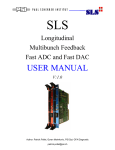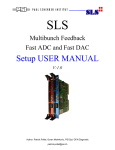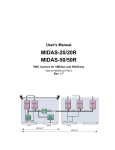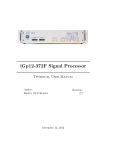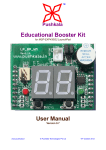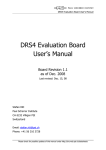Download USER MANUAL - Diagnostic
Transcript
SLS Transversal Multibunch Feedback Fast ADC and Fast DAC USER MANUAL V:1.0 Author: Patrick Pollet, Goran Marinkovic, PSI Dpt. GFA Diagnostic [email protected] I. Generalities • Goal: The synchrotron beam at the Swiss Light Source (SLS) in Villigen-PSI needs to be monitored and stabilized to achieve its rated performance. • Why a bunch feedback system: An electron beam circulating in a ring at speed close to that of light excites electro-magnetical fields; this em-field energy is deposed locally for a certain amount of time around the whole accelerator structure. This stored energy may cause unwanted transversal beam oscillation under certain conditions. The task of the feedback system is to damp these oscillations. A. The bunch feedback system parts • The position detection part receives the beam signals through pickups and normalizes them. • An ADC is clocked with the machine RF (round 500MHz) and samples the oscillation of each bunch separately. • The digital processing part buffers and calculates the correction signal based on the ADC sample. • A DAC is as well clocked with the machine RF (round 500MHz) and converts the calculated correction signals back to an analogue value • The amplifier scales the correction signals and provides the power to the kicker to generate the fields in order to correct (damp) the bunch oscillation. Baseband Signal (500MHz) RF Front End A/D Correction Signal (500MHz) Digital Processing D/A RF Amplifier Wideband Signal Hybrid Network Pickup Kicker Fig. 1 Multibunch feedback system overview. One of the main problems is a correct setup of the system in order to calculate the correction signal on basis of the previous samples of the same bunch and to kick this particular bunch only. Paul Scherrer Institut • 5232 Villigen PSI MBFB_ADC_DAC_User_Manual.doc/ 12/13/06 /page 2 of 27 B. Signal processing hardware The signal processing hardware consists of: • 1 VME ADC unit. • 1 VME DAC unit. The ADC and the DAC unit communicate with each other via standard FPDP – bus. Configuration and control of the feedback system is done via standard VME-bus access. Clock DAC Board Commute Gain FPDP FIR A/D FPDP IIR Analogue IN Grey to Binary ADC Board M U X FPDP FPDP M U X Analogue OUT D/A FPDP Start ADC FPDP Start DAC Clock Clock Distribution External External Clock Shift Clock Setting Fig. 2 ADC-DAC Digital Processing Electronics Architecture. C. Signal processing hardware overview The ADC and DAC units consist of an assembly of two VME 6HE sized boards. The lower of the two boards drives the FPDP interface, the upper board is the unit controller or main board. The main board contains different functionalities: • VME slave interface. • Unit controller. • ADC controller if an ADC-Mezzanine board is plugged in. • DAC controller if a DAC-Mezzanine board is plugged in. • The main board is also responsible for upper/lower board data transfer and hand shake. Paul Scherrer Institut • 5232 Villigen PSI lower upper mezzanine MBFB_ADC_DAC_User_Manual.doc/ 12/13/06 /page 3 of 27 1. ADC and DAC Mainboard According to the block diagram below, the mainboard allows various data flows. The data flow within the board is controlled by means of the FPGA (XILINX™ XC2V1000-6-FG456C) firmware. The data flow controls the interaction between VME bus access, a fast buffer (ZBT RAM), the ADC/DAC and the FPDP interface. The ADC and DAC board contains a fast RAM buffer denoted as ZBT RAM, which stores the ADC samples and the DAC values consistently in a ring buffer. The buffer is constructed such that at each address the bunch with the same number is stored, hence giving a good possibility to observe a particular bunch. This ring buffer is needed primarily for setting up the system and observing the beam movement at runtime of the MBFB. The mainboard hardware configuration is almost (one exception is the terminating resistors on the main board) the same for the ADC and the DAC board, only the type of mezzanine (ADC or DAC) and the FPGA firmware are distinguishing between the functionality of the two units. VME Bus Interface VME Bus Interface Address32 & Control 5V TTL & Data32 LVDS @125MHz Clock & Control LVDS ADC Mezanine Address20 & Control LVTTL Data32 LVDS @125MHz Clock & Control LVDS DAC Mezanine FPDP Board Connector Xilinx Virtex II FPGA Data8 LVDS DDR @250MHz Data32 TTL @40MHz Address32 & Control 5V TTL & Data32 TTL @40MHz Data16 LVDS @250MHz Address & Control LVDS Address20 & Control LVTTL Data32 LVTTL @125MHz possible data flow directions ZBT-RAM FPDP Board Connector Xilinx Virtex II FPGA Address & Control LVDS Data32 LVTTL @125MHz ZBT-RAM possible data flow directions Fig. 3 Possible data flow in the ADC and DAC board. FPGA Dataflow The FPGA is configured either as ADC or as DAC controller. Please note: It is strictly forbidden to swap the mezzanine boards without clearing first the FPGA firmware. If a board with an unknown firmware is used then the first thing to do is to clear the content of the configuration EPROM by means of the XILINX® Impact tool. Paul Scherrer Institut • 5232 Villigen PSI MBFB_ADC_DAC_User_Manual.doc/ 12/13/06 /page 4 of 27 II. ADC Interface A. ADC Dataflow within the FPGA The incoming analogue signal is sampled at a rate of 500 MHz. Once enabled, the ADC outputs a 500 MSamples/s, 8 Bit LVDS differential DDR data bus with a synchronous LVDS clock at 250 MHz. The 8 bit data is then demultiplexed (1 to 4 DEMUX) to produce a 32 bit wide FPGA internal data bus at 125 MHz. This bus passes to a Gray to Binary decoder, an IIR filter, an 8tap FIR filter, a bunch gain control, a 2 way data redirector (commute) and finaly the FPDP interface. This data redirector may send the data either differentially to the FPDP-demux daughter board or to the ZBT RAM ring buffer or to both of them at the same time. The output dataflow is synchronous with the reference clock (250 MHz). Interface to ZBT RAM Gray2Bin ADCData(8) D E M U X IIR 8tap FIR Gain 32 8 8 8 8 8 8 8 8 8 8 Commute 8 8 8 8 8 8 8 8 8 8 32 Interface to FPDP Board FPDPData(32) Fig. 4 ADC-FPDP Dataflow Paul Scherrer Institut • 5232 Villigen PSI MBFB_ADC_DAC_User_Manual.doc/ 12/13/06 /page 5 of 27 B. ADC LEDs The ADC VME board has 3 LEDs which visualise the status of the board. The 3 LEDs are denoted as X, Y and Z. LED X Color off green red Y Z yellow off green red yellow off green red yellow X Y Z Description Should never happen. Check power or hardware defect. The clock system in the FPGA is working properly. Due to the implementation of the clock system this indicates that the RF clock jitter is less than 150ps and no RF clock period was missed. The clock system in the FPGA is NOT working properly. Due to the implementation of the clock system this indicates that the RF clock jitter was/is bigger than 150ps and/or RF clock period was missed. Not implemented. Currently no VME access to this card. VME signalling access. VME signalling acknowledge. Both of the above. VME Commute directing ADC data to ZBT RAM buffer and FPDP interface. VME Commute directing ADC data to FPDP interface only. VME Commute directing ZBT RAM buffer data to FPDP interface (a debugging feature). VME Commute directing ADC data to ZBT RAM buffer only. C. Registers and functionality 1. Address 0x000000 (Status Register) a) 21: DVALID The FPDP bus transmits the DVALID bit set. b) 0: 125 MHz Clock Lock This bit is set if the clocks are working according to the specs of the DCM (Digital Clock Manager) inside the FPGA. For more information on the DCM please refer to the XILINX datasheet of the VirtexII FPGA. 2. Address 0x000010 (Control Register) a) 31:Board Reset A write access at this bit causes: o Stop of any running acquisition. o Reset the FPDP interface. Paul Scherrer Institut • 5232 Villigen PSI MBFB_ADC_DAC_User_Manual.doc/ 12/13/06 /page 6 of 27 o Reset all registers to their default values. o Set all memory pointers to their base address. o Reinitialization of the board hardware. b) 21…20: Run Mode Select o 00: External Trigger mode. The acquisition is started by the FPGA internal timer. o 01: Software trigger mode. The acquisition is started internally by Software trigger. o 10: no action o 11: no action c) 12: FPDP Reset Setting this bit will reset the FPDP address counter and the FPDP strobes signals. After “Board Reset” this bit is set to 1, therefore the FPDP is driven into its initial stage and waits for the start signal (DVALID). d) 5…4: Commute Controlls the dataflow in the FPGA. o 00: ADC data to FPDP and to ZBT RAM o 01: ADC data to FPDP only o 10: ZBT RAM data to FPDP o 11: ADC data to ZBT RAM only e) 0: Acq Enable Setting this bit will enable the clock on the ADC mezanine board. 3. Address 0x000020 (Firmware Version) This register holds the actual firmware version number for verification purposes o [27..24] : Hexadecimal “A” o [23..20] : Hexadecimal “D” o [19..16] : Hexadecimal “C” o [15…0] Firmware Version Nr (4x Hex Number) Paul Scherrer Institut • 5232 Villigen PSI MBFB_ADC_DAC_User_Manual.doc/ 12/13/06 /page 7 of 27 4. Address 0x000040 (ZBT RAM Stop Address) During acquisition, this register contains the last written RAM address. The last address will be kept until a new acquisition cycle is started. Please note: Although the last written RAM address is stored, the main address counter is updated internally and hence starts writing the ring buffer at the correct position for the actual bunch number. 5. Address 0x000110 (ZBT RAM Last Address) The last ZBT RAM address (max usable size) of the used memory should be adjusted to an integer multiple of the complete bunch turns to be stored in memory. If the RAM size is set with a value which is not an integer multiple of complete bunch turns, then a “data jump” at the end of the buffer memory is caused. Which means: The same memory position (address) is not storing the information of the same bunch number but of different bunches. E.g the bunch with a specific number is not stored at the same address when the ZBT RAM buffer is filled. An example for setting the correct value: Nr. of bunches per turn = 480 Nr. of bunches stored with each address = 4 (data organisation of the ZBT) Size of memory = 4194304 Bytes (organized as 1048576 x 32bit => 4 samples/address) Last memory address = (4194304 / 480) * (480 / 4) - 1 = 1048559 = 0xFFFEF 6. Address 0x000120 (ADC Clock Phase Timing Settings) This register contains the ADC clock phase timing for sampling the ADC data at rising and falling clock edges. Please note: The base for the rising edge clock is the 250 MHz reference clock and the base for the falling edge timing is the rising edge clock. This means if you are modifying the rising edge timing, then the falling edge timing is modified as well! The default values set in this register are evaluated by means of measurement and work nicely for the given boards. Modify these registers only with care. a) 31..24: Timing of ADC Clock Falling Edge A write access at this address moves the sampling point of the ADC read at the falling edge of the 250 MHz adc clock. The sampling point is calculated as follows: sampling_falling_edge = sampling_falling_edge_value*(2ns/256) Paul Scherrer Institut • 5232 Villigen PSI MBFB_ADC_DAC_User_Manual.doc/ 12/13/06 /page 8 of 27 Sampling_falling_edge = delay between rising edge of the sample clock to the falling edge of the sampling clock. This value is used for the DCM (Digital Clock Manager) inside the FPGA, for more information on the DCM please refer to the XILINX datasheet of the VirtexII FPGA. b) 16..23: Timing of ADC Rising Edge A write access at this address moves the sampling point of the ADC read in contrast to the rising edge of the 250MHz reference clock. The sampling point is calculated as follows: sampling_rising_edge = sampling_rising_edge_value*(2ns/256) Sampling_rising_edge = delay between rising edge of the sampling clock to the rising edge of the reference clock. This value is used for the DCM (Digital Clock Manager) inside the FPGA, for more information on the DCM please refer to the XILINX datasheet of the VirtexII FPGA 7. Address 0x000130-0x000140 (ADC Start Timing Setting) This register contains the ADC and DAC start timing setting. The ADC is started when the delay timer is started (“Bunch delay trigger”) and after a programmable delay (“Bunch delay”) a start signal for the DAC card is generated. E.g. the delay for the ADC to DAC start is defined and triggered by these registers here. a) Address 0x000130 (Bunch delay trigger) If bit 0 is set set (to ‘1’), then the internal timer is loaded with the value stored in the “Bunch delay” register (address 0x000140) and started in order to trigger the DAC start. If bit 0 is reset (to ‘0’) then the internal timer is reloaded and waits to be triggered again to start the DAC. b) Address 0x000140 (Bunch delay). This register contains the bunch delay in 2ns steps. The delay value range is 0 to 16384. The delay is calculated as follows: delay = (delay _ value + 1) * 2ns 8. Address 0x000190 (ADC Enable IIR Filter Setting) This register contains the enable signal for IIR filtering in the ADC. If bit 0 is set (to ‘1’), then the IIR filter is enabled. If the IIR filter is enabled then following formula is used for each bunch sample separately with a resolution of 2 −20 : 7 y n = ( y n −.1 + x n ) − 8 x n 8 If IIR is disabled (to ‘0’) then the formula is simply: Paul Scherrer Institut • 5232 Villigen PSI MBFB_ADC_DAC_User_Manual.doc/ 12/13/06 /page 9 of 27 y n = −8 x n Graphically the IIR filter looks like the follows. 8 y(n)=x(n) * 2^20 y(n)=x(n) * 2^23 32 16 y(n)=7/8 * y(n-1) + x(n) 32 0 iir_enable 0 1 16 16 Fig. 5 IIR filter Please note: The figure above shows only the mathematical behaviour for each bunch, it does not show the implementation in detail, e.g it does not show the intermediate storage for the 480 bunches. Paul Scherrer Institut • 5232 Villigen PSI MBFB_ADC_DAC_User_Manual.doc/ 12/13/06 /page 10 of 27 9. Address 0x0001C0-0x0001E0 (Gain) The FIR gain control has two main tasks to handle. One task is the programmable gain without adding more bit-noise to the output and the second is to saturate the output at gains too large to be expressed in a signed 8 bit number (2complement number). The gain control is fed by the FIR filter calculation with 36 bit in 2complement representation. These registers contain the gain settings for the 479 bunches of the SLS ring. One bunch is controlled separately by a gain and is not influenced by the general gain register. Gain was defined to be the bit shift beginning at the MSB position (35) and a sign extension as the following figures shows. FIR calculation 35 bit 34 0 8 bit 34 34 34 0 0 9 bit 34 34 34 1 0 10 bit 34 34 34 2 0 11 bit 34 34 34 3 0 12 bit 34 34 34 4 0 13 bit 34 34 34 0 5 35 bit 34 0 27 8 LSB bit scaled value Fig. 6 Gain and saturation control Please note: The figure above shows the 8 LSB bit scalled value as output which is saturated. This means numbers too big to be expressed in 8 bits are set to the biggest 8 bit number possible in order to suppress rollover faults. Paul Scherrer Institut • 5232 Villigen PSI MBFB_ADC_DAC_User_Manual.doc/ 12/13/06 /page 11 of 27 a) Address 0x0001C0 (Gain all bunches) This register contains the gain for the 479 bunches of the SLS ring. One bunch is controlled by the gain bunch register and not by this register here. The gain range is 0 to 26. b) Address 0x0001D0 (Gain particular bunch). This register contains the gain of one particular bunch, which is selected by the “gain bunch” register (address 0x0001E0). The gain range is 0 to 26. c) Address 0x0001E0 (Gain bunch). This register contains the number of the bunch for which the “gain particular gain” is active. The gain bunch range is 0 to 479. 10. Address 0x000200-0x000270 (8tap FIR filter) For filtering of the 480 bunches in the SLS ring following 8 tap FIR filter design was implemented. For each bunch z-7 successively values are stored and shifted in a dual ported RAM and used for the calculation of the FIR filter. i_fir_coef(1) i_fir_coef(0) Z-1 i_fir_in i_fir_coef(2) Z-1 i_fir_coef(3) Z-1 i_fir_coef(4) Z-1 i_fir_coef(5) Z-1 i_fir_coef(6) Z-1 i_fir_coef(7) Z-1 X X X X X X X X Saturation control 0 o_fir_out Fig. 7 8tap FIR filter a) Address 0x000200 (8 tap FIR filter coefficient 0) This register contains the 8 tap FIR filter coefficient 0 (i_fir_coef(0)). The coefficient value range is -32768 to 32767. Paul Scherrer Institut • 5232 Villigen PSI MBFB_ADC_DAC_User_Manual.doc/ 12/13/06 /page 12 of 27 b) Address 0x000210 (8 tap FIR filter coefficient 1) This register contains the 8 tap FIR filter coefficient 1 (i_fir_coef(1)). The coefficient value range is -32768 to 32767. c) Address 0x000220 (8 tap FIR filter coefficient 2) This register contains the 8 tap FIR filter coefficient 2 (i_fir_coef(2)). The coefficient value range is -32768 to 32767. d) Address 0x000230 (8 tap FIR filter coefficient 3) This register contains the 8 tap FIR filter coefficient 3 (i_fir_coef(3)). The coefficient value range is -32768 to 32767. e) Address 0x000240 (8 tap FIR filter coefficient 4) This register contains the 8 tap FIR filter coefficient 4 (i_fir_coef(4)). The coefficient value range is -32768 to 32767. f) Address 0x000250 (8 tap FIR filter coefficient 5) This register contains the 8 tap FIR filter coefficient 5 (i_fir_coef(5)). The coefficient value range is -32768 to 32767. g) Address 0x000260 (8 tap FIR filter coefficient 6) This register contains the 8 tap FIR filter coefficient 6 (i_fir_coef(6)). The coefficient value range is -32768 to 32767. h) Address 0x000270 (8 tap FIR filter coefficient 7) This register contains the 8 tap FIR filter coefficient 7 (i_fir_coef(7)). The coefficient value range is -32768 to 32767. Paul Scherrer Institut • 5232 Villigen PSI MBFB_ADC_DAC_User_Manual.doc/ 12/13/06 /page 13 of 27 III. DAC Interface A. DAC dataflow within the FPGA. The DAC FPGA receives a 32 bit data word at 125 MHz from the FPDP daughter board. The FPDP data passes a redirector (Commute) before the data is stored in a synchronization FIFO. The synchronization FIFO read out is started at detection of the “START DAC” signal. The origin of this “START DAC” signal is the delay timer of the ADC board. The data redirector (Commute) may send the data either the synchronization FIFO or to the ZBT RAM ring buffer or to both of them at the same time. Finally the DAC interface multiplexes the synchronization FIFO data to the output ports A and B at a frequency of 250 MHz synchronously to the DAC reference clock. Interface to ZBT RAM 32 DACDataA(8) DACDataB(8) M U X 32 Synchronization FIFO 32 Commute 32 Interface to FPDP Board FPDPData(32) Fig. 8 FPDP – DAC FPGA data flow Paul Scherrer Institut • 5232 Villigen PSI MBFB_ADC_DAC_User_Manual.doc/ 12/13/06 /page 14 of 27 B. DAC LEDs The DAC VME board has 3 LEDs which visualise the status of the board. The 3 LEDs are denoted as X, Y and Z. LED X Color off green red Y Z yellow off green red yellow off green red yellow X Y Z Description Should never happen. Check power or hardware defect. The clock system in the FPGA is working properly. Due to the implementation of the clock system this indicates that the RF clock jitter is less than 150ps and no RF clock period was missed. The clock system in the FPGA is NOT working properly. Due to the implementation of the clock system this indicates that the RF clock jitter was/is bigger than 150ps and/or RF clock period was missed. Not implemented. Currently no VME access to this card. VME signalling access. VME signalling acknowledge. Both of the above. VME Commute directing FPDP data to ZBT RAM buffer and DAC. VME Commute directing FPDP data to DAC only. VME Commute directing ZBT RAM buffer data to DAC (a debugging feature). VME Commute directing FPDP data to ZBT RAM buffer only. C. DAC Registers and functionality 1. Address 0x000000 (Status Register) a) 27: FIFO Overflow The synchronization FIFO overrun or data was read before it was stored in the FIFO. b) 26: FIFO Full The synchronization FIFO is full. c) 25: FIFO Half Full The synchronization FIFO is half full. d) 24: FIFO Empty The synchronization FIFO is empty. e) 21: DVALID The FPDP bus received the DVALID bit set. Paul Scherrer Institut • 5232 Villigen PSI MBFB_ADC_DAC_User_Manual.doc/ 12/13/06 /page 15 of 27 f) 16: START DAC Start for reading the synchronization FIFO detected. The origin of this “START DAC” signal is the delay timer of the ADC board. g) 0: 250 MHz Clock Lock This bit is set if the clocks are working according to the specs of the DCM (Digital Clock Manager) inside the FPGA. For more information on the DCM please refer to the XILINX datasheet of the VirtexII FPGA. 2. Address 0x000010 (Control Register) a) 31: Board Reset o Stop any running acquisition o Reset the FPDP interface. o Reset all registers to their default values o Set all memory pointers to their base address o Reinitialize board hardware b) 21…20: Run Mode select o 00: External trigger mode. The acquisition is started by external event “START DAC”. o 01: Software trigger mode. The acquisition is started internally by Software trigger. o 10: no action o 11: no action c) 12: FPDP Reset Setting this bit will reset the FPDP bus interface. After “Board Reset” this bit is set (to ‘1’), therefore the FPDP is driven into its initial stage and waits for the start signal. d) 5…4: Commute o 00: FPDP data to DAC and to ZBT RAM o 01: FPDP data to DAC only o 10: ZBT RAM data to DAC o 11: FPDP data to ZBT RAM only Paul Scherrer Institut • 5232 Villigen PSI MBFB_ADC_DAC_User_Manual.doc/ 12/13/06 /page 16 of 27 e) 0: Acq Enable Setting this bit will enable the DAC to receive start signals. Disabling this bit, stops the acquisition. 3. Address 0x000020 (Firmware Version) This register holds the actual firmware version number for verification purposes o [27…24] : Hexadecimal “D” o [23…20] : Hexadecimal “A” o [19…16] : Hexadecimal “C” o [15…0] Firmware Version Nr (4x Hex Number) 4. Address 0x000040 (ZBT RAM Stop Address) During acquisition, this register contains the last written RAM address. The last address will be kept until a new acquisition cycle is started. Please note: Although the last written RAM address is stored, the main address counter is updated internally and hence starts writing the ring buffer at the correct position for the actual bunch number. 5. Address 0x000110 (ZBT RAM Last Address) The last ZBT RAM address (max usable size) of the used memory should be adjusted to an integer multiple of the complete bunch turns to be stored in memory. If the RAM size is set with a value which is not an integer multiple of complete bunch turns, then a “data jump” at the end of the buffer memory is caused. The same memory position (address) is not storing the information of the same bunch but by different bunches. E.g the bunch with a specific number is not stored at the same address when the ZBT RAM buffer is filled. An example for setting the correct value: Nr. of bunches per turn = 480 Nr. of bunches stored with each address = 4 (data organisation of the ZBT) Size of memory = 4194304 Bytes (organized as 1048576 x 32bit => 4 samples/address) Last memory address = (4194304 / 480) * (480 / 4) - 1 = 1048559 = 0xFFFEF Paul Scherrer Institut • 5232 Villigen PSI MBFB_ADC_DAC_User_Manual.doc/ 12/13/06 /page 17 of 27 IV. FPDP daughter board timing A. Samples description Each FPDP word is made of four 8 bit samples. After starting the ADC acquisition the data out of the FPDP ports are ordered as shown. FPDP #1 FPDP #2 FPDP #3 FPDP #4 Sample 1 Sample 5 Sample 9 Sample 13 Sample 2 Sample 6 Sample 10 Sample 14 Sample 3 Sample 7 Sample 11 Sample 15 Sample 4 Sample 8 Sample 12 Sample 16 bit 31 bit 24 bit 23 bit 16 bit 15 bit 8 bit 7 bit 0 Fig. 9 Samples B. Differences between ADC and DAC transfers In ADC-mode, the ADC FPGA is FPDP master. The lines “FPDP_Data”, “FPDP_DValid”, “FPDP_Strobe” and “FPDP_Address” are driven by the ADC FPGA. The signal “MCLK” (master clock) is derived from the reference clock (250MHz). “FPDP Reset”, is controlled by the VME interface. Three additional signals, “Commute[1…0]” and “AcqEnable”, are needed to enable the data redirection through the commute element according to the following table: Commute ACQEnable Legend 00 1 ADC Data to FPDP and to ZBT RAM 01 1 ADC Data to FPDP only 10 1 ZBT RAM Data to FPDP 11 1 ZBT RAM to ADC xx 0 No acquisition Paul Scherrer Institut • 5232 Villigen PSI MBFB_ADC_DAC_User_Manual.doc/ 12/13/06 /page 18 of 27 The “FPDP_Address” is set by an internal modulo 6 counter. The count width is given by the signals “VMEFPDPAddress[3…0]”. This counter is reset at initialization and delivered in parallel with the data to the FPDP interface. Example: Sample FPDPData[7:0] FPDPData[15:8] FPDPData[23:16] FPDPData[31:24] FPDP Address 0 ADCData(n+3) ADCData(n+2) ADCData(n+1) ADCData(n) 0 1 ADCData(n+7) ADCData(n+6) ADCData(n+5) ADCData(n+4) 1 … … … … … … 5 ADCData(n+23) ADCData(n+22) ADCData(n+21) ADCData(n+20) 5 6 ADCData(n+27) ADCData(n+26) ADCData(n+25) ADCData(n+24) 0 7 ADCData(n+31) ADCData(n+30) ADCData(n+29) ADCData(n+28) 1 … … … … … … In DAC-mode, DAC FPGA is the FPDP slave. The lines “FPDP_Data”, “FPDP_DValid” and “FPDP_Strobe” are driven by the FPDP-daughter board. The signal “MCLK” (master clock) is derived from the reference clock (250MHz). “FPDP_Reset” is controlled by the VME interface. “FPDP_Sync” can be used to resynchronize data in this working mode and should not be used at the moment. Two additional signals, “Commute[1…0]” and “AcqEnable”, are needed to enable the data redirection through the commute element according to the following table: VMECommute VMEAcqEnable Legend 00 1 FPDP Data to DAC and to ZBT RAM 01 1 FPDP Data to DAC only 10 1 ZBT RAM Data to DAC 11 1 FPDP Data to ZBT RAM xx 0 No Acquisition Paul Scherrer Institut • 5232 Villigen PSI MBFB_ADC_DAC_User_Manual.doc/ 12/13/06 /page 19 of 27 V. VME Interface A. Setting the VME Board Base Address Using a VME 64x crate, the board base address is set according to the slot geographical address map. The VME address switch SW2 should be disabled (all switch in position off) to assure a correct address decoding. Any 5 consecutive address lines range can be used (A31..A27; A27..A22 etc…) for the board address mapping, giving a maximal address space of 128 MByte per VME slot if using the 5 upper address lines (A31.. A27). The decoded address lines are selected by the rotating hex coder switch SW3. SW3 0 1 2 3 4 5 6 7..F Address lines decoded A31…A27 A30…A26 A29…A25 A28…A24 A27…A23 A26…A22 A25…A21 Not available Address space 128 MByte 64 MByte 32 MByte 16 MByte 8 MByte 4 MByte 2 MByte B. Board base address adjustment On normal VME64x crates the adjustment can only be set by choice of the correct slot and by use of the switch SW3. On crates where geographical addressing is not available, the geographical addresses should be set manually, using switch SW2. SLOT 1 2 3 4 5 6 7 8 9 10 11 12 13 14 15 16 17 GA_Lines 00001 00010 00011 00100 00101 00110 00111 01000 01001 01010 01011 01100 01101 01110 01111 10000 10001 0 08000000 10000000 18000000 20000000 28000000 30000000 38000000 40000000 48000000 50000000 58000000 60000000 68000000 70000000 78000000 80000000 88000000 Paul Scherrer Institut • 5232 Villigen PSI 1 04000000 08000000 0c000000 10000000 14000000 18000000 1c000000 20000000 24000000 28000000 2c000000 30000000 34000000 38000000 3c000000 40000000 44000000 2 02000000 04000000 06000000 08000000 0a000000 0c000000 0e000000 10000000 12000000 14000000 16000000 18000000 1a000000 1c000000 1e000000 20000000 22000000 3 01000000 02000000 03000000 04000000 05000000 06000000 07000000 08000000 09000000 0a000000 0b000000 0c000000 0d000000 0e000000 0f000000 10000000 11000000 4 00800000 01000000 01800000 02000000 02800000 03000000 03800000 04000000 04800000 05000000 05800000 06000000 06800000 07000000 07800000 08000000 08800000 5 00400000 00800000 00c00000 01000000 01400000 01800000 01c00000 02000000 02400000 02800000 02c00000 03000000 03400000 03800000 03c00000 04000000 04400000 6 00200000 00400000 00600000 00800000 00a00000 00c00000 00e00000 01000000 01200000 01400000 01600000 01800000 01a00000 01c00000 01e00000 02000000 02200000 MBFB_ADC_DAC_User_Manual.doc/ 12/13/06 /page 20 of 27 18 19 20 21 10010 10011 10100 10101 90000000 98000000 a0000000 a8000000 48000000 4c000000 50000000 54000000 24000000 26000000 28000000 2a000000 12000000 13000000 14000000 15000000 09000000 09800000 0a000000 0a800000 04800000 04c00000 05000000 05400000 02400000 02600000 02800000 02a00000 C. Use of the VME32 crate The boards are VME32 compatible, but since +3.3V power supply is not available on VME32 crates, few hardware changes need to be done: o Mainboard Jumper CB3 should be set. o FPDP board Jumper JP1 should be set. Paul Scherrer Institut • 5232 Villigen PSI MBFB_ADC_DAC_User_Manual.doc/ 12/13/06 /page 21 of 27 VI. JTAG Programming For upgrade purposes a JTAG connector is accessible on the ADC and DAC front panel. This connector accesses only the mainboard FPGA. For upgrading the FPDP-board, the assembly should be dismounted in order to access the JTAG connector placed at the top side of the board. The Xilinx programming environment may be downloaded at http://www.xilinx.com/webpack/ A. ADC/DAC Programming 1. Connector Pinout: 1: TCK 5: TMS 2: GND 9: TDI 3: TDO 10: GND 4: VCC 2. Programming steps o Copy the ADC or DAC files to a directory on your PC. o Plug the board in and switch power on. Connect the JTAG cable. Start Xilinx Impact program: start => Programs => Xilinx ISExy => Accessories => Impact By the popup menu “Operation Mode Selection”, choose <Configure Device> and press <Next>. By the popup menu “Configure Device”, choose <Boundary-Scan Mode> and press <Next>. By the popup menu “Boundary-Scan Mode Selection”, choose <Automatically connect> and press <Finish>. The programs will check the connection and ask for a configuration file, choose dac_fpga.mcs or adc_fpga.mcs. Be aware of which board type you reprogram! Right-click on the top of the PROM-Chip icon (xc18v04) and choose <program> in the selection list. You should get to the window on the left. o Press OK to program the board. Paul Scherrer Institut • 5232 Villigen PSI MBFB_ADC_DAC_User_Manual.doc/ 12/13/06 /page 22 of 27 B. FPDP Board Programming 1. Connector Pinout 1: VCC 9: TDO 3: GND 11: TDI 7: TCK 13: TMS 2. Preparation steps o Unscrew the two lock screw by the JTAG connector and the four screws at the INOUT/Clock SMA connector. o With the help of a small screwdriver, very carefully unplug the reset connector on the back of the mainboard. o Unscrew the four screws on the mainboard, don’t touch the screw on the ADC/DAC mezzanine boards. o Plug-in the FPDP board into the VME Crate and switch the power on. o Connect the JTAG cable. 3. Programming steps o Launch Xilinx Impact program as explained before. o By the popup menu “Operation Mode Selection”, choose <Configure Device> and press <Next>. o By the popup menu “Configure Device”, choose <Boundary-Scan Mode> and press <Next>. o By the popup menu “Boundary-Scan Mode Selection”, choose <Automatically connect> and press <Finish>. o By the popup menu “Boundary-Scan Chain …”, press OK. o By the popup menu “Assign New Configuration File select <Readback.mcs> for the xc18V04 device and by the next menu select <BYPASS>. o Right-click on the top of the PROM-Chip icon (xc10v04) and choose <program> in the selection list and press OK. Paul Scherrer Institut • 5232 Villigen PSI MBFB_ADC_DAC_User_Manual.doc/ 12/13/06 /page 23 of 27 VII. Mechanics Paul Scherrer Institut • 5232 Villigen PSI MBFB_ADC_DAC_User_Manual.doc/ 12/13/06 /page 24 of 27 Paul Scherrer Institut • 5232 Villigen PSI MBFB_ADC_DAC_User_Manual.doc/ 12/13/06 /page 25 of 27 Paul Scherrer Institut • 5232 Villigen PSI MBFB_ADC_DAC_User_Manual.doc/ 12/13/06 /page 26 of 27 References E.Kikutani, J. Flanagan and M. Tobiyama (KEK) Limitations of multibunch feedback systems and extrapolation D. Bulfone (Elettra). Specifications of the ADC and DAC Boards for the ELETTRA/SLS Multi Bunch Feedback Systems D. Bulfone, M. Lonza (Elettra), M. Dehler (SLS), R. Ursic (Instrumentations technologies) Multibunch Feedback presentation at the Beam Instability Workshop, Grenoble ESRF March 2000. P.Pollet (SLS). ADC/DAC firmware specifications part I, II, III and IV. R. Kramert (SLS). Datasheet MBFB-FPDP. Paul Scherrer Institut • 5232 Villigen PSI MBFB_ADC_DAC_User_Manual.doc/ 12/13/06 /page 27 of 27



























